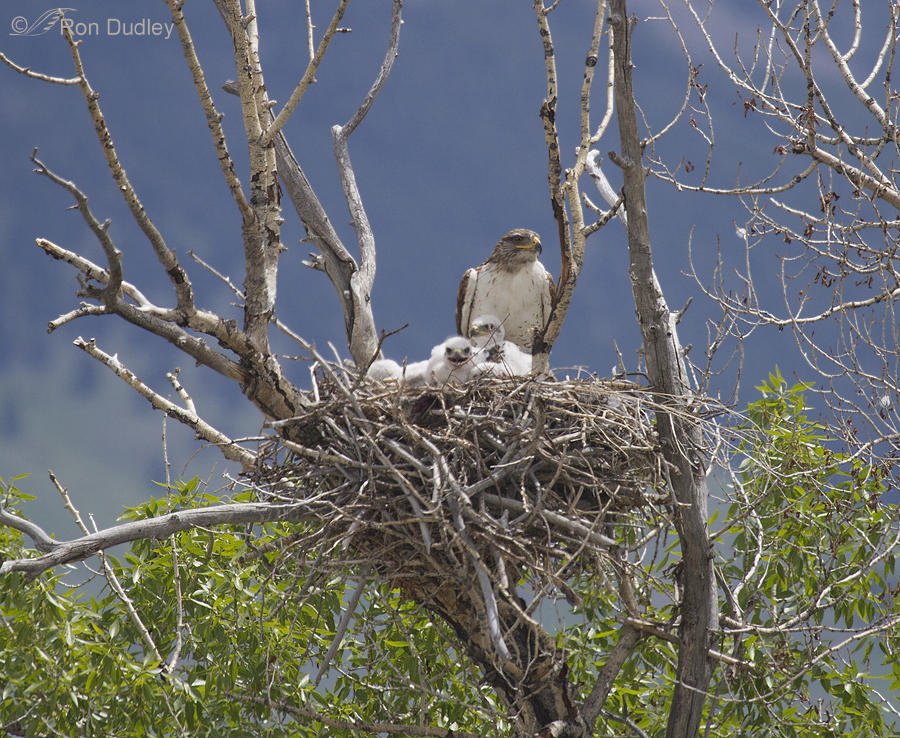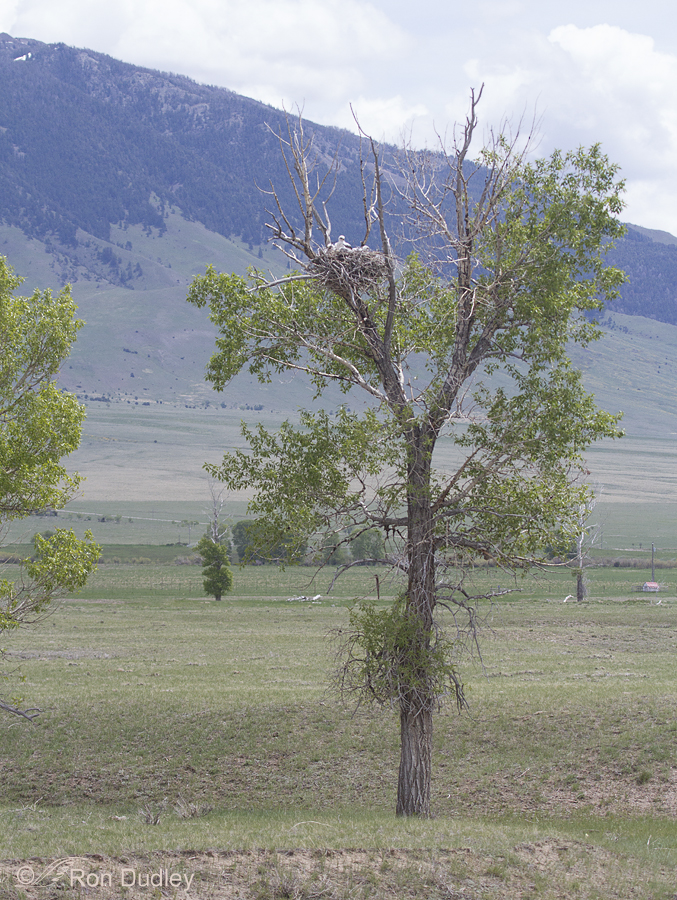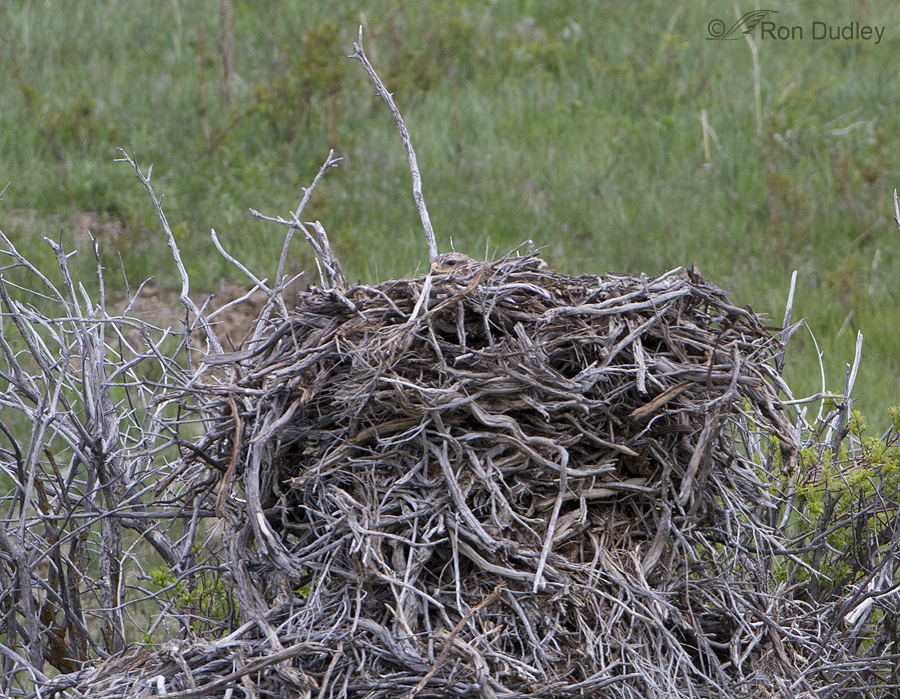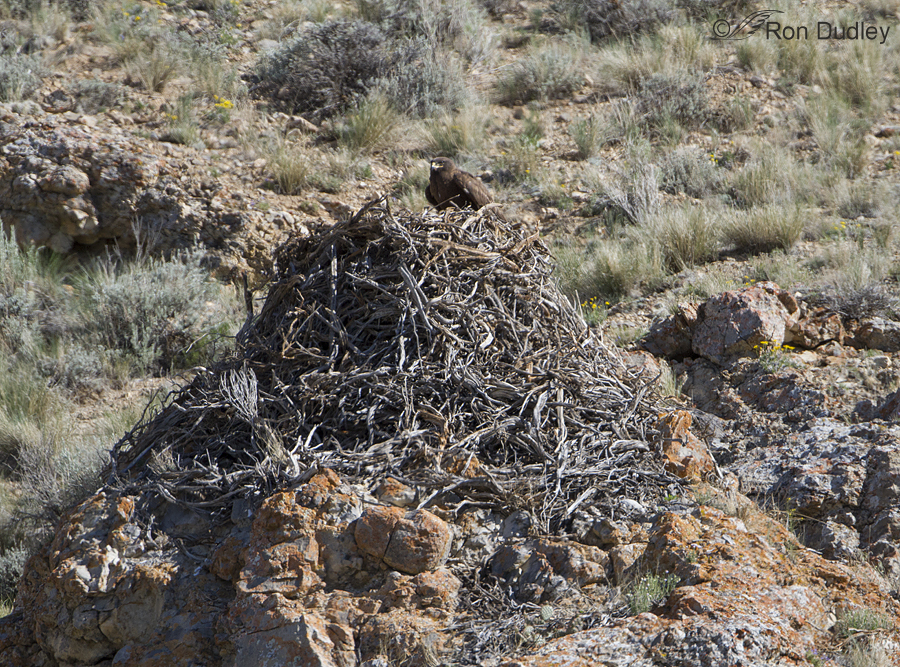This past summer I photographed several active Ferruginous Hawk nests and was impressed by their size differences and the variation in elevations of the nests from the ground. Each of these nests was photographed in southwest Montana in June of this year.
Ferruginous Hawks are remarkably flexible in nest site selection, probably because elevated nesting sites in their preferred habitat are scarce. Of the three widely nesting buteos in North America (Ferruginous, Red-tailed and Swainson’s Hawks), this species nests closest to the ground on average.
This nest is relatively small for the species, I suspect because it’s a relatively new construction. These birds often reuse nests for years and add to them annually.
Roughly half of their nests are in relatively low trees and shrubs (this is the same nest as in the previous image), though they also nest on cliffs, ground outcrops and utility structures. This nest isn’t as elevated as it might appear because the tree is growing in a gully.
We found this nest in a half-dead shrub only a few feet off the ground, though it is on the side of a hill so my shooting angle makes it appear higher. As you can see the nest is massive (notice the hawk’s head for size perspective) and probably quite old.
Up until about 1900 these hawks often used bleached bison bones (particularly ribs) in nest construction and you can see by the size of these twigs and branches that they’re fully capable of carrying such large construction pieces to the nest.
When artificial nest platforms are provided for this species, in order to get maximum usage from the hawks they’re typically built to a height of only 6 to 14′.
But this is probably the largest and oldest Ferruginous Hawk nest I’ve seen (this bird is a dark morph). It was built on the ground, atop a rocky outcrop.
Researchers believe that ground nesting prevailed in the distant past, partly because it’s likely that trees are more prominent now then they were before prairie fires were controlled. The bulky and inflexible sticks these birds use for their nests cannot easily be woven and held together in trees so when Ferruginous Hawks build elevated nests in trees they typically use nests of smaller raptors or corvids as a base or substrate.
Ferruginous Hawks are particularly sensitive to nest disturbance by humans and I took care to avoid causing them any alarm. Each of these nests was close to a road and the hawks have become acclimated to traffic. I always photographed them from the road and never got out of my pickup. I noticed no signs of nervousness from the hawks.
Ron






Great Post, Ron!
I greatly enjoyed seeing the different nests and the substrate. Most interesting was the ground nest. While I have heard of these, I haven’t ever actually seen one.
Cheers,
Gail Garber
Wow, again! and thank you for the fascinating info and photos>
Great post Ron. I love the last Ferrug nest especially. I can only imagine what a nest like that would have looked like with a number of bison bones added in.
I can’t say any more than the rest of these folks have. You’re top billing Ron!
You already have written a book: an ebook! Wonderful nest shots Ron. There’s almost as much character in the structures as there is in their inhabitants. Unlike more transient Swainson’s or Red-tailed nests, coming upon a massively built old Ferruge nest evokes the same kind of thoughts I get while pondering an ancient Anasazi or Fremont dwelling. How many generations were raised here? What became of them? What dramas played out in there? If only those sticks could talk…
We’re two of a kind in that regard, Mike. I have the very same thoughts – when I’m actually there and then again when I’m looking at the photos.
Wow and thank you for the interesting information and beautiful pics…I love Dudley’s classroom, lol!
You’re so right about Ron’s “classroom”…He’s still prepping for his next class(blog), researching and sharing information with his “students” which is now a HUGE, world-wide class, and, like all the best teachers, still learning from his students! He never did retire! Don’t tell him, though…we’ll just let him think he did….
Once again you made me smile, Patty. Thanks for that.
Susan, Guess I’ve never left the classroom, at least in some ways. Interesting – this kind of focus was never my conscious intent when I started blogging, it just evolved…
I think the telling argument for classifying the Ferruginous as a possible eagle candidate would be its DNA it is closer related to the Rough-legged than the Golden. Nest fidelity is weaker than many eagles and much of their hunting style similar to Goldens may well be more a matter of often common habitat factors (although they don’t prefer mountainous areas) than size. Nor do they practice siblicide or fratricide. The Golden has many commonalities with other Booted Eagle species and the Bald with other Sea Eagle species.
Thanks once again for your insight regarding raptors, Bill. Always appreciated.
Another great elarning experience!! Thanks Ron. Always amazing photos. Never stop your photography!!
I won’t, Ellen – as long as there’s birds and I’m still kicking. Thank you.
Incredible. Beautiful. Amazing. And all the other superlatives. Thank you.
You’re very welcome, Elephant’s Child.
I’ve seen references to a movement by some in the field to reclassify and rename Ferrugs as eagles.
To add to the list of nest lining materials provided by Bill Dove, add the fact they often used to use bison “wool”.
To those suggesting I write a book, I very much appreciate your encouragement and apparent confidence in me but I just don’t have the time (or the ambition). If I took on such a project I’d have to give up either my photography or my blog for a time – something I’m not willing to do. Besides, that sounds like a lot of work and I like my “retired” lifestyle as it is now…
Much as I’d love to have a book from you, I have to agree with you on choosing the “retired” life-style. Life is much more pleasant that way. 🙂
That makes sense to me…as a retired teacher myself, I understand not wanting to “should” on yourself by taking on more of ANYTHING at this point. You put so much into your photography, including very early hours, long drives, braving some nasty, frustrating conditions, personally responding to our questions and comments, and looking up facts and information, etc. So, I’ll be happy with what I get and make my own “book” by keeping up with your blog and driving you nuts with my questions!
Several commenters have noted the similarities to eagles, and the comments are spot on. “Eagle” is a somewhat subjective term applied to birds of widely varying size and shape worldwide. Here in NA, we
use the term for certain large raptors (Bald Eagle, Golden Eagle, Steller’s Sea Eagle).
That said, here’s a quote from “Hawks in Flight”, by Pete Dunne, David Sibley and Clay Sutton. I use it whenever we encounter ferrugies on one of my outings. “If the Ferruginous Hawk were an Old World raptor, it would almost certainly be called an eagle….the Ferrug manifests the hunting skills (and many of the techniques) of a Golden Eagle”.
So readers of this post have keen powers of observation. But then, we knew that! 🙂
Cheers,
Dick
Terrific information and, naturally, splendid photographs! I would love to see one of these large raptors! As others have mentioned, the nests are similar to something and eagle would construct. Really massive!
Thank you, Ron!
I’ll add my name to the list of those who would like to see you publish a book. It’s definitely one I would want to own. These hawk nests are very interesting, and if you hadn’t mentioned the hawk’s head for perspective in the 3rd photo, I don’t think I would have seen it – until I looked closely, I thought it was just another twig in the nest… Great camouflage.
Hi Ron,
Nests fit for a king, I’d say. Let’s call the bird “regalis”. 🙂
Thanks for these great images and stories, and special thanks for mentioning the species’ sensitivity. Big and beautiful, Ferruginous Hawks have great charisma,
and some folks are naturally drawn to them, wanting to get better looks. I only know of two traditional nest sites, and we ALWAYS scope them from afar.
I make a point of it, so that people get to see the bird as well as “get the message”. Thanks again!
Cheers,
Dick
I echo Dick’s sentiment. Thanks so much for the fabulous info. I really appreciate it.
Amazing Constructions Ron. And I agree with both Patty and Dick.Your Photography and Observations would make incredible book or field guide !
I agree with Dick Harlow about “the book”…and still say it’s already written….just needs to be compiled.
Interesting…even their nests are eagle-like in construction, including size of wood used, massiveness of the nest itself, the fact that they add to them each year…so many eagle similarities. I’ve seen an old golden eagle nest in Wyoming that was built on a rocky outcropping only about 15 or 20 feet off the ground. It amazes me how carefully “woven” these nests are, especially with such irregular, twisty pieces of stiff, dry wood. I wonder how they make the inside smooth enough for their tender babies.
They do have many eagle similarities but also many dissimilar characteristics and behaviors. Their average clutch size is one very significant difference from eagles.
They often use cow patties (not to be confused with meadow muffins), road apples, roots from sagebrush, different barks and grasses to line the nest bowl.
Bill
Great series Ron, many thanks for sharing.
You really should write a book. Your photo essays on your blog are terrific and very informative. Much appreciated.